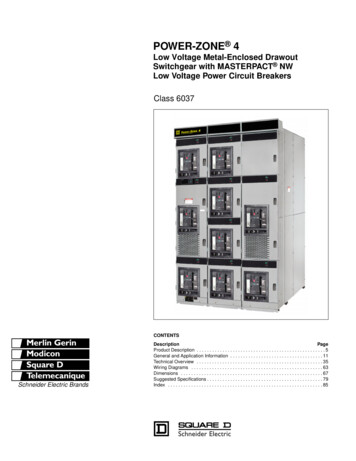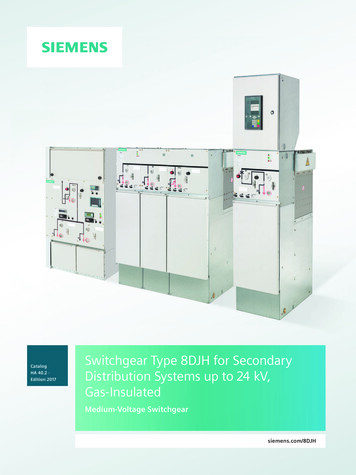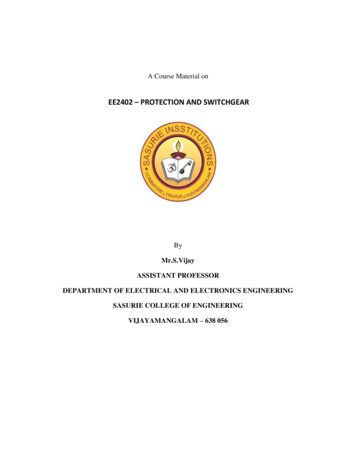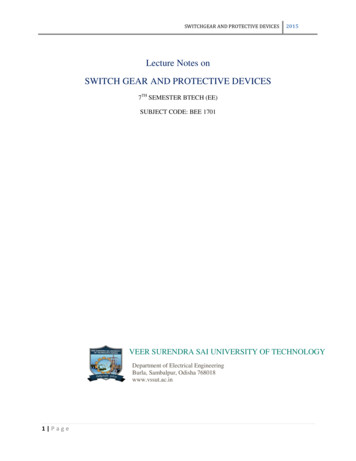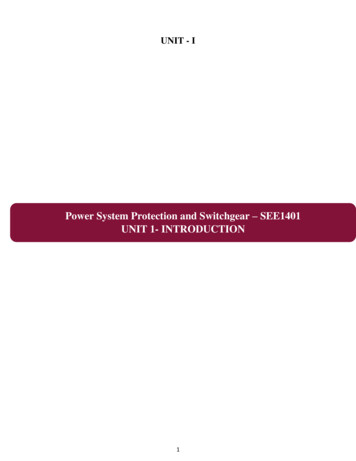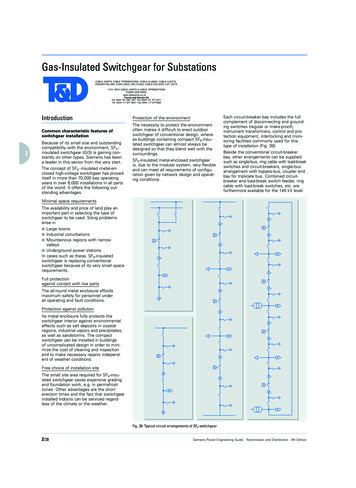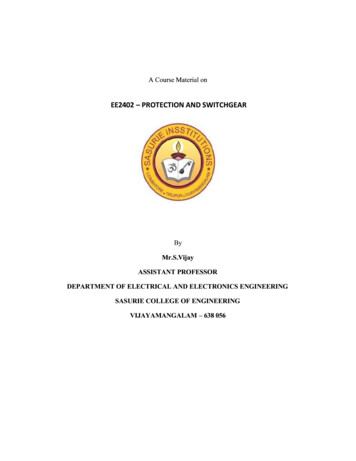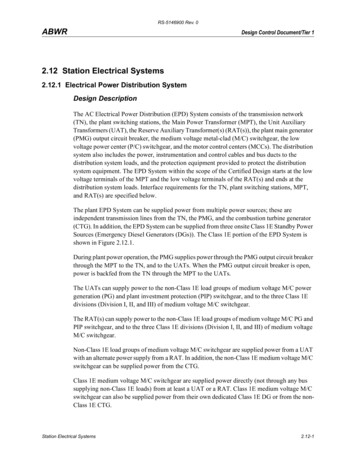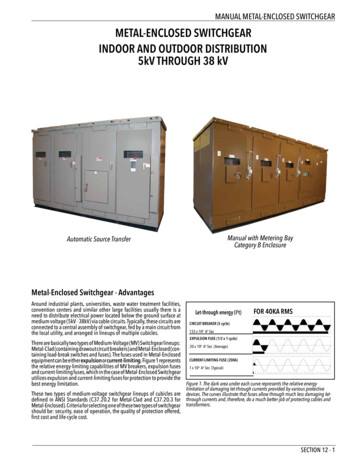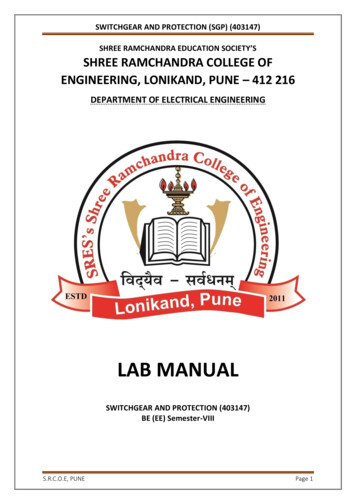
Transcription
SWITCHGEAR AND PROTECTION (SGP) (403147)SHREE RAMCHANDRA EDUCATION SOCIETY’SSHREE RAMCHANDRA COLLEGE OFENGINEERING, LONIKAND, PUNE – 412 216DEPARTMENT OF ELECTRICAL ENGINEERINGLAB MANUALSWITCHGEAR AND PROTECTION (403147)BE (EE) Semester-VIIIS.R.C.O.E, PUNEPage 1
SWITCHGEAR AND PROTECTION (SGP) (403147)INDEXSr. No. Name of Experiment1.Study of switchgear testing kit.2.Study of Fuse, MCB & their testing3.Study and testing of contactors4.Study and testing of thermal overload relay for Induction Motorprotection5.Study and plotting Characteristics of IDMT type Induction over currentrelayPage No.3-078-1112-1718-2324-276.Percentage differential protection of transformer28-297.Protection of alternator30-36Study of various LT switchgears like RCCB, timers37-458.S.R.C.O.E, PUNEPage 2
SWITCHGEAR AND PROTECTION (SGP) (403147)SHREE RAMCHANDRA COLLEGE OF ENGG. LONIKANDPRACTICAL EXPERIMENT INSTRUCTION SHEETLABORATORY MANUALEXPERIMENT TITLE: STUDY OF SWITCHGEAR TESTING KITEXPERIMENT NO. : SRCOE/ELECT/BE/SGP/01SWITCHGEAR AND PROTECTION (403147)DEPT. : ELECTRICAL ENGINEERINGSEMESTER : II (BE)PAGE:03-07STUDY OF SWITCHGEAR TESTING KITAIM:To study the switchgear testing kit.APPRATUS (Specifications):Sr.No.Name of EquipmentRangeVariable AC current:0-50 Amp. with 500 VA/1000VAVariable AC voltage:0-230 V AC, 2 Amps.Variable DC voltage:0-230 V DC, 2 Amps.Mains Input:(three terminal instrumentplugs provided.)Outputs:Normal 230V AC, 50 Hz, mainsVariable AC current source: 0- 20A.VA burden maximum: 200VA.Timer OFF connection from relay contacts.Monitors:Other components:Time counter: Range: 0- 999.99 milli secondswith auto range. Accuracy: /- 0.05%.Mains ON/OFF switch, Indication Lamps, SturdyCurrent variable knob.DESCRIPTION:This unit is specially designed to suit relay testing requirements of power stationtestingengineers. Purpose of modern instrumentation engineering is to reduce the totalinstrumentweight and still give single equipment which can be used for testing of differenttype ofpower system relays. The unit is a portable. Stability and accuracy of digitalindicationis in-built. Numbers of functional units are included in single cabinet. They can beusedS.R.C.O.E, PUNEPage 3
SWITCHGEAR AND PROTECTION (SGP) (403147)individual or in association with other unit. The connection terminals are front loadedandplug in or wire connections can be used.The set operates on single phase 230 Volts, AC, 50 Hz power supply and providesacontrollable test voltage and completely adjustable output current. The unit is housed inapowder coated sheet metal panel with table mounting facility, detachable lid, latchesandcarrying handles. All the switches, terminals, meters and knobs are mounted on frontofthe panel, with properlabels. Terminals for the test voltage, current source and relay contactterminals are provided on the front Ammeter and digital time interval meter is also providedon thefront of the panel for metering purpose. The ammeter will indicate in the percentage oftherange selected and the voltmeter will indicate the voltage. Mains ON indication isprovided. The voltage circuit and current circuit can be used simultaneously.FEATURES: Micro controlled based time measuring unit with 1 ms resolution.Special provision for relay’s ON delay/OFF delay time measurement.Specially designed for testing of all types of IDMT over current relay/under-overvoltage relay/Auxiliary relay.Designed for checking the operating characteristic of protective relay on site.With timer control circuit, timer automatically starts output is initiated and stops whenthe.Auto cut-off facility.Provided with Single pole IDMT Over Current/ Earth fault relay.Numerical/ Electromechanical type of Relay with Secondary CT ratio 1A/ 5A.PROCEDURE TO USE CURRENT SOURCE:1.2.3.4.5.Connect the relay coil to current range selector.Switch on Mains.Select current range from current selector switchTo adjust current range for the injection, keep the timer open, marked as V & C2.Push the stat button, after staring, the timer gets started & current to be injected should be asper indication on the ammeter as % of the selected range.6. After setting the current range, short the time terminals, to automatically stop the currentsource.7. Now connect the NO contactor the relay to the timer terminals are marked as V & C2.8. Reset the timer & reset the current circuit by pushing the start button& current will be injected& relay will be operated. The NO contacts turn NC & the timer circuit gets automatically cutoff.9. After testing of the relay for 2 to 3 times at various ranges, zero the current control knob.10. Switch OFF the main supply.S.R.C.O.E, PUNEPage 4
SWITCHGEAR AND PROTECTION (SGP) (403147)PROCEDURE TO USE VOLTAGE SOURCE:1. Switch ON main switch.2. Select AC/DC voltage source as per requirement by switching selector switch to 1 or 2Position for AC /DC source respectively.3. The voltage can be adjusted from the voltage control knob as per requirements.4. After using for various operations turn OFF the voltage selector switch.5. Turn OFF main switch & before zero voltage control knob is zero.6. Voltage is shown on the voltmeter on the respective meters for Ac & DC.Procedure for Time Vs Current (IDMT)Characteristics test1) Connect the relay coil (termination ) to the current source (Terminated as ).as shown in the figure 1.2) Connect the Aux. contact of the relay ( ) to the Timer contact of the kit ( ).3) Connect the 230V AC supply to the kit4) Keep the TMS setting at maximum position (1 sec).5) Keep the Phase setting plug at 2.5A (50%) Setting6) Switch ON the unit and push the Start Push button.7) Now slowly increase the current value upto 3A by adjusting the current variable knob.8) Switch OFF the output by pushing the stop PB and reset the Timer without changing the setting9) Switch ON the output, which will also start timer. Timer will stop counting when the relay tripsNote the delay.10) Repeat the procedure for various current values as per table no. 1.2.11) Switch OFF the mains supply.Procedure for Testing TMS Setting1) Connect the relay coil (termination ) to the current source (Terminated as ).as shown in the figure 1.2) Connect the Aux. contact of the relay () to the Timer contact of the kit ( ).3) Connect the 230V AC supply to the kit.4) Keep the TMS setting at minimum position (0.1s).5) Keep the Phase setting plug at 2.5A (50%) Setting.6) Switch ON the unit and push the Start Push button.7) Now slowly increase the current value up to 3.5A by adjusting the current variable knob.8) Switch OFF the output by pushing the stop PB and reset the Timer without changing the setting.9) Switch ON the output, which will also start timer. Timer will stop counting when the relay tripsNote the delay.9) Repeat the procedure for various TMS setting values as per table no. 1.3.10) Switch OFF the mains supply.S.R.C.O.E, PUNEPage 5
SWITCHGEAR AND PROTECTION (SGP) (403147)OBSERVATION TABLETable No. 1.1 Pick up Test TMS(Time Multiplier setting) Setting- 1 Sec.Sr.No.1.2.3.4.5.6.7.% Set (I )2.5A (50%)3.75A (75%)5A (100%)6.25A (125%)7.5A (150%)8.75A (175%)10A (200%)Current (Amps)Table no. 1.2: Time Vs. Current (IDMT) Characteristics for O/C or EFTMS Setting: 1 Sec.Phase trip setting as 2.5A (50%)Set current at3A5A7.5A10A3ATime in Sec.Set current at5A7.5A10A15ATime in Sec.Set current at7.5A10A15A20ATime in Sec.Phase trip setting as 3.75A (50%)Phase trip setting as 5A (100%)Table no. 1.3: TMS Setting Test:S.R.C.O.E, PUNEPage 6
SWITCHGEAR AND PROTECTION (SGP) (403147)Current to be injected : 3.5 ATMSSwitchPositionPhaseSwitchAt 2.5 AX 0.1X 0.2X 0.5X 0.75X 0.1CONCLUSION:In this way we studied the switchgears testing kit .S.R.C.O.E, PUNEPage 7
SWITCHGEAR AND PROTECTION (SGP) (403147)SHREE RAMCHANDRA COLLEGE OF ENGG. LONIKANDPRACTICAL EXPERIMENT INSTRUCTION SHEETLABORATORY MANUALEXPERIMENT TITLE: STUDY OF FUSE & MCB & TESTING OF MCBEXPERIMENT NO. : SRCOE/ELECT/BE/SGP/02(A)SWITCHGEAR AND PROTECTION (403147)DEPT. : ELECTRICAL ENGINEERINGPAGE:08SEMESTER : II (BE)10STUDY OF FUSE & MCB & TESTING OF MCBAIM:Study of FusesTHEORY:The fuse is a protecting device of simplest form. It consists of a small piece of metal when excessivecurrent flows through it. The metal elements melts & the current is interrupted & the circuit getsdisconnected from the supply .Thus it protects the circuit from dangerous excessive current. So fuseis used to interrupts a fault current .It is simple protective device which works on the principal ofcurrent interruption, if current through it becomes excessive.Types of fuse1. Expulsion fuses2. Cartridge fuse3. Drop out fuse4. Liquid fuse5. Open fuse6. Striker fuse7. Switch Fuse8. HRC Fuse1. Expulsion Fuse The Expulsion fuse consists of modern cutout. In such fuse the arc occurring during the currentinterruption is extinguished by the expansion produced by the arc.2. Rewirable Fuse or Semi closed FuseIn such a fuse the fuse element is placed in a semi closed carrier. Fuse carriers can be pulled out &the fuse element can be replaced, after the fuse operation. The carrier can be then placed in the fusebase.Such fuses are very commonly used in our houses.3. Cartridge Fuse –This fuse is totally enclosed fuse. The fuse element is placed in a totally enclosed carrier with twoMetal contacts provided on the two sides of a carrier. The entire cartridge is required to be replacedonce fuse operates.4. Drop-out Fuse –S.R.C.O.E, PUNEPage 8
SWITCHGEAR AND PROTECTION (SGP) (403147)In such fuse, the fuse carrier drops out once, the fuse operates, the dropping out of fuse carrier providesthe necessary isolation between the terminals.5. Liquid Fuse –When fuse operates, in case of high current there exists an arc. The arc must be extinguished properly.The fuse in which the arc is extinguished using a liquid medium is called liquid fuse. The liquidmedium used is generally oil. The various types of liquid fuses are:a) Oil breakb) Oil expulsion fusec) Oil blast fuse6. Open FuseThis fuse consists of a plain fuse wire and the fuse operates any provision for extinguishing thearc.7. Striker FuseIn this fuse, there exists a combination of a fuse and a mechanical device. When the fuseoperates,strikes get released under pressure which gives the tripping indication.8. Switch FuseThis fuse is a combination of a switch & fuse. The combined unit is called switch fuse.9. HRC FuseIt is high rupturing capacity fuse. It is also called breaking capacity cartridge fuse. In such afuse the arc is extinguished with the help of quartz, sand powder such a powder provides veryhigh resistance which helps to extinguish the arc. It is basically a low voltage fuse which is usedfor various distribution purposes.DEFINITIONS:1] Fuse – The fuse is device which consists of a small piece of metal which is connected in seriescircuit when current through it increases beyond some predetermined value, the metal melts tointerrupt the circuit current which protects the circuit from excessive high current.2] Fuse element – The part of the fuse which melts excessive current flows through it is calledfuse element or fuse wire.3] Current rating of wire – It is that maximum current which fusing element can normallyWithstand without any undue overheating or melting. It depends on:i) Temperature rise of fuse contacts of fuse holderii) Fusing elements materialS.R.C.O.E, PUNEPage 9
SWITCHGEAR AND PROTECTION (SGP) (403147)iii) Determination of fuse due to oxidation.4] Fusing factor – The ratio of the minimum fusing current & the current rating of fuse is called thefusing factor. As minimum fusing current is more than the current rating. The fusing factor is alwaysgreater than ‘1’.5] Prospective current – The figure shows how the ac current is cut off using a fuse. This iscalled cut-off characteristic of fuse. The rms value of the 1 st loop of the fault current calculated iffuse is assumed to be replaced by a link of a negligible resistance is called the prospective current.6] Cut-off current – The current value at which the fuse melts before fault current achieve its peakvalue is called cut- off current.7] Pre-arcing time – The time between the commencement of the fault current and the instant whenthe fuse melts & the arc starts is called pre-arcing time.8] Arcing time – The time between the end of pre-arcing time and the instant when the arcgets completely extinguished is called arcing time.9] Braking capacity – The braking capacity is the fuse rating corresponding to the rms value of theac component of maximum prospective current at its rated service voltage.10] Pre-arcing (I2 t) – It is the time integral of the square of current passing through the fusingduring pre-arcing time.11] Arcing (I2 t) – It is the time integral of the square of the current through the fuse during the arcingtime.12] Clearing (I2 t) – It is the sum of the pre-arcing I2 t and the arcing I2 t is called clearingI2 t or total I2 t.13] Voltage rating of fuse – The voltage rating of fuse is specified by the manufacture. The ratedvoltage of the fuse must be equal or greater thani) Voltage of a single phase circuitii) Line voltage in case of three phase circuitiii) Voltage between two outer wires in 3 wire dc circuit.CONCLUSION:In this way we have studied the different types of fuses.S.R.C.O.E, PUNEPage 10
SWITCHGEAR AND PROTECTION (SGP) (403147)SHREE RAMCHANDRA COLLEGE OF ENGG. LONIKANDPRACTICAL EXPERIMENT INSTRUCTION SHEETLABORATORY MANUALEXPERIMENT TITLE: STUDY OF FUSE & MCB & TESTING OF MCBEXPERIMENT NO. : SRCOE/ELECT/BE/SGP/02(B)SWITCHGEAR AND PROTECTION (403147)DEPT. : ELECTRICAL ENGINEERINGSEMESTER : II (BE) PAGE:-11AIM :To study Miniature Circuit Breaker (MCB).CONSTRUCTION :As the name indicates, miniature circuit breaker is housed in moldings of insulating materials, whichalso has fire resistance property normally ceramic. The MCB consists of a bimetallic strip forthermal overload protection as well as instantaneous magnetic release type short circuit protection.These releases are fixed on each pole and in case of three phase circuit they are connected to commonconnecting base.FUNCTION :MCB automatically isolates the electrical circuit under sustained overload or short circuit. A bimetallicelement provided on inverse time current characteristic which prevents interruption on normal inrushcurrents or temporary overload. An instantaneous magnetic trips release protects the equipmentsagainst very high currents. MCB‘s are available in 3 tripping circuit via B, C, D.Considering the fusing factor and aging effect of rewirablefuse, the smaller transformer of 25to200 KVA will be better protected with MCB.OBSERVATION TABLE :Sr. No.1.2.3.CurrentTime in Sec.CONCLUSION :Hence we have studied the working of miniature circuit breaker (MCB) and testing of miniaturecircuit breaker MCB is also performed successfully.S.R.C.O.E, PUNEPage 11
SWITCHGEAR AND PROTECTION (SGP) (403147)SHREE RAMCHANDRA COLLEGE OF ENGG. LONIKANDPRACTICAL EXPERIMENT INSTRUCTION SHEETLABORATORY MANUALEXPERIMENT TITLE: STUDY & TESTING OF CONTACTORS.EXPERIMENT NO. : SRCOE/ELECT/BE/SGP/03SWITCHGEAR AND PROTECTION (403147)DEPT. : ELECTRICAL ENGINEERINGSEMESTER : II (BE) PAGE:12-17STUDY & TESTING OF CONTACTORS.AIM:To study & test the contactors.APPARATUS: Switchgear testing kit, contactors & connecting wires etc.THEORY:Contactor is mechanical switching device capable of making, carrying & breakingelectric currentunder normal circuit conditions including operating overload conditions.Acontactor iselectromagnetically operated switches which can be operating remotely.Contactor may be capableof making & braking short circuit currents, if they are designed for short circuit of emerging thecontrol circuit namely.SOME TERMS & DEFINITIONS –Electromagnetic contactor – A contactor in which the opening & closing of mainContacts is achieved by means of an electromagnet.Electropneumatic contactor – A contactor in which the force for closing & openingThe main contacts is provided by an electrically opening pneumatic device.Main Circuit – The conducting parts of the contactor designed to close & open. Thecurrent flows from the supply to load through the main circuit of the contactor.Main Contacts – The contacts in the main circuit to carry the load current when thecontactor is closed position.Control Unit – The circuit which is energized or de-energized electrically for openingS.R.C.O.E, PUNEPage 12
SWITCHGEAR AND PROTECTION (SGP) (403147)/closing operation the contactor.Auxillry circuit – The circuit other than main & control circuit is called auxillary circuit.PRINCIPAL:When a definite voltage is applied the coil energizes an electromagnet system comprising of fixed& moving parts, the moving parts get attracted to fixed part. Thus the electrical circuit is completedthrough this contact system. When magnet is de-energized, it gets pushed back by return spring &contacts open & thus electric circuit is broken.CONSTRUCTION OF TYPICAL CONTACTOR:Parts of contactor & their function:Rubber Padding:-It is provided for absorbing shocks during closing and opening the contactor.Magnets :- AC magnets are made up of laminations stacked together to reduce effect of eddy currents.Since in DC frequency is zero, problems of eddy currents losses & hysteresis losses do notexist & hence no laminations are required.There is designed gap between the central limb of fixedmagnet & the moving magnet.When this gap reduces over millions of operations or magnetstarts bulging it indicate thatmechanical life of contactor is over & needs replacement.If duringmaintenance or cleaning, emery or sand paper is used for the magnets the designedgap betweenthe central limb increases as surface material reduces, increasing the air gap.Hence while openingthis remains some residual magnetic flux which does not allowthe moving magnet to separateimmediately, causing severe pitting of contacts. This resultin frequent changing of contacts.Thus wage of emery or sand, paper should be avoided at magnets; it can be cleaned withCRC-2-26 / CTC & rough cloth.Contact System :The contacts are made up of cadmium alloy. These have well anti welding properties. The gapbetween the contacts is less than that between magnets which ensures that contacts areS.R.C.O.E, PUNEPage 13
SWITCHGEAR AND PROTECTION (SGP) (403147)closed before magnet pole faces touch each other.LEAF Spring : The moving contacts have to be held under certain contact pressure which is ensured byproviding leaf springs over the contact carrier bridge. It also helps in bounce free closingReturn Spring :The moving assembly is held against the stored energy of two main springs called as returnsprings which helps the bridge assembly in opening the contact.Shading ring :In A.C. magnets alternating flux (main flux) goes through natural zero point so force ofattraction created becomes zero.This results in repeated de -energization of the magnets & leads tochattering.Some additional force is require to hold the magnet when main flux passes through zero.It does this by generating an auxiliary flux which is out of phase with main flux, theshading ring is embedded in the pole face of the magnet for this.Terminals:- Terminals are made up of silver plated copper and are provided for both powercircuit & control circuit terminators.Auxiliary contacts :Set of normally open (NO) & normally close (NC) contacts are available for indication & alarmpurpose.Arc Chute Set :While breaking high currents between the contacts needs to be effectively quenched.Arc is quenched by following 3 methods:1) Arc is split by providing number of Deion-plates.2) The arc or current when drawn to Deion plates induces a voltage across the plates which3) opposes the cause producing it. (arc) as per Lenz’s Law4) The resistance of the arc specific resistivity x length of arcS.R.C.O.E, PUNEArea of arcPage 14
SWITCHGEAR AND PROTECTION (SGP) (403147)Due to splitting of arc its length increases as resistance of arc is directly proportional tolength. The resistance of arc increases & thus arc is quenched.Housing :Material having good thermal withstand and mechanical strength are used for housing.Mostly ceramic ,SMC ( sheet moulded compound ) & DMC (dough moulded compound )are used for front housing while Die- cast . Aluminum is used for rare housing.SPECIFICATION OF CONTACTOR:1) Rated Voltage – 415 V2) Rated coil voltage – coils are available in various voltage rating eg.24,48,380,240,415 etc(AC/DC)3) Contactor has following main current ratings & is selected as per the type of load ie.(application)Rated current forAC1 – Resistive loadAC2 – Slightly Inductive load ( e.g. slip ring induction motor )AC3 – Highly inductive load (e.g. Squirrel cage I.M. normal operation)AC4 – Inching & highly inductive load like squirrel cage induction motor.Contacts can be fitted with following accessories –1. Auxiliary contact blocks (add on block )2. Mechanical interlock etc.3. Surge suppressor.Advantages of contactors:1. High number of make- break operations2. High making & braking capacity3. Remote ON/OFF4. High mechanical & electrical lifeDisadvantages of contactors:S.R.C.O.E, PUNEPage 15
SWITCHGEAR AND PROTECTION (SGP) (403147)1. It cannot sense fault itself.2. It should be installed with relay unit.3. Therefore it becomes costly.Applications of contactors:Remote controlling:Mobile applications, Telecommunication, security, water pumps, green houses,remote power generator, solar systems, traffic control, field control, In agricultural industrieswhere voltage is less & voltage fluctuations are more.Programming controllers.Voltage Monitors - They provide protection against phase loss, phase reversal.Over, under &unbalanced voltage. It will also protect motor against voltagefaults. It will operate when voltage isexceeding the set value.Illumination control.1. Timers2. Starters – Contactor starter from motor1. D.O.L. contactor starter2. Reversing contactor starter3./ contactor starter3. Air break contactors are used in L.V. switchgear. (suitable for large no.of switching operations on load/ over load )4. Key or push button.5. Auxiliary switches.6. Medium voltage vacuum contactors ( 3.6 to 12 KV)(suitable for controllingA.C. loads with high switching rate & unlimited on time)7. Switching off –S.R.C.O.E, PUNE-3 Ø motor in A.C. 3 duty-Transformers-Capacitors-Resistive load (electric furnace )Page 16
SWITCHGEAR AND PROTECTION (SGP) (403147)8. There is also an upcoming ‘Biological contactor technology ‘for Mine efficienttreatment.PROCEDURE :1) Check the rated voltage of contactor coil2) Keep the contactor in vertical position.3) Connect the coil terminals of the contactor to voltage output terminalsof the test panel4) For pick up voltage test, increases the voltage gradually till contactsclose without humming.OBSERVATION TABLE:RatedPick-upDrop-offVoltage (V)Voltage ( V)Voltage (V)VVVCurrent rating APick up voltage V (85 to 110 % of rated coil voltage)Drop off. Voltage V (10 to 70 % of rated coil voltage)CONCLUSION:Thus we have observed the testing of contactor. It is rated for V& it’s pick up & drop offvoltage is V and V respectively.S.R.C.O.E, PUNEPage 17
SWITCHGEAR AND PROTECTION (SGP) (403147)SHREE RAMCHANDRA COLLEGE OF ENGG. LONIKANDPRACTICAL EXPERIMENT INSTRUCTION SHEETLABORATORY MANUALEXPERIMENT TITLE: STUDY & CHARACTISTICS OF THERMAL OVERLOAD RELAYEXPERIMENT NO. : SRCOE/ELECT/BE/SGP/04SWITCHGEAR AND PROTECTION (403147)DEPT. : ELECTRICAL ENGINEERINGSEMESTER : II (BE) PAGE:18-23STUDY & CHARACTISTICS OF THERMAL OVERLOAD RELAYAIM :To study and test thermal overload relay.APPARATUS : Thermal overload relay ( 500 V , 50 Hz , 2 A AC ) Contactors Switch gear testing panelTHEORY :Thermal overload relay prevent an electric motor from drawing excess current and overheating .Thermal overload conditions are the most likely faults to be encountered in industrial motor application, which produces an increase in the motors, Thermal dissipation and temperature . Overload protectionprevents on electric motor from drawing excess current , overheating and finally bumping out.Thermal overload relays can be bimetallic relays , eutectic alloy relays, temperature control or proberelays and solid state relays. A bimetallic device is made up of two strips of different metals . Thedissimilar metals are permanently joined . Heating the bimetallic strips causes it to bend because ,the dissimilar metals expand & contracts at different rates. The bimetallic strips applies tension to aspring on a contact. It heat begins to rise the strip bends and spring pulls the contact apart breaking thecircuit. A melting alloy ( or electric ) overload relay and a mechanical mechanism to activate atripping device when an overload occurs.The relay measures the temperature of the motor by monitoring the amount of current being drawn.S.R.C.O.E, PUNEPage 18
SWITCHGEAR AND PROTECTION (SGP) (403147)This is done indirectly through a heater coil. Temperature control relays are used to protect the motorby directly sensing the temperature of the windings using thermister of RTD probes . The motor musthave on or more positive temperature co-efficient thermister probes embedded in its windings.When nominal operating temperature of the probe is reached, its resistance increases rapidly .This increase is detected by a threshold circuit which controls a set of relay contacts solid staterelays have no moving or mechanical parts. The relay calculates the average temperatures within themotor by monitoring its starting and running current. A solid state relay is also another type of overcurrent relay.PRINCIPLE OF OPERATION :A bimetal is formed by two metals with unequal coefficient of linear expansion brazed together in theform of strip. When heated strip bends one end is fixed and other bends when heated under overload/single phasing.CONSTRUCTIONS :The over current relay operates on thermal effect of electric current. Basically , it consist of a bimetallicstrips . The bimetallic strip is nothing but two metal strips having different co-efficient of thermalexpansion joined together . Here one end is supported and fixed and uneven expansion caused bendingof strips. This operates the relay contacts . The fig. shows the construction of overload thermal relay.It consists of following partsUpper Slider bar :One end of slider bar is connected to spring for pull action and other end is connected to spring for pullaction and other end is connected to contact tripping level and top pivot points when bimetallic stripbends due to overload / unbalance current, this upper slider bar moves and pushes the contact trippinglevel , i.e. The upper slider bar is movable.Lower Slide bar :-S.R.C.O.E, PUNEPage 19
SWITCHGEAR AND PROTECTION (SGP) (403147)One end is connected to spring which has push action and other end is connected to bottom pivot pointand contact tripping level. This bar has slots for carrying bimetallic strip. The spring apposes movementof contact tripping lever towards contact carrier i.e. lever slide bar is fixed one.Bimetallic strips :It is made up of metal strips having different co-efficient of thermal expansion. They are three innumber and housed in slots of lower slider. It gets supply from CT’s for high currents.WORKING :Under normal conditions :Strips are strained; contacts tripping lever is in vertical position and relay contacts are in normalposition.Under overload condition :Currents are greats than normal but balanced and hence all three bimetal and bend equally. Thelower slider moves towards contact right and pushes control carrier. Hence NC contacts open whichgivessignal to the contactor and supply is cut off.Suppose the R phase opens therefore any bimetalsof Y and B phases operates due to bending of other two bimetals. Thus for the same power, the othertwo phase bimetals operates and trip the circuitproviding the single phasingproduction.Effect of over loading / over heating :The effect of overloading is an incipient fault which generally cause the damage of the insulation issupported to withstand certain temperature without damage. If the temperature increases beyondthis for long periods , then the insulation deteriorates . The final stage is breakdown of insulation, thusthis reduces the life of motor and so it becomes necessary to prevent this overheating due tooverloading.Causes of overheating : Overload high currentS.R.C.O.E, PUNEPage 20
SWITCHGEAR AND PROTECTION (SGP) (403147) Supply variation – low voltage result in high current Heavy starting – high starting current. High starting frequency – motor is required to start often. High duty factor – motor remains on for long periods and off for short periods. Single phasing complete load comes on two windings hence high current. Faulty bearings and other mechanical reasons. Defect in cooling systems for very large machines.Advantages of Thermal overload Relays :As the motor gets damaged due to higher temperature and causes of higher temperature arebasically higher currents, the most commonly used protection is of current sensing devices ,bimetallic thermal relay is used extensively.The main advantages are :Thermal overload relay gives protection for both balance and unbalance faults.They give protection against overloading & single phasing .The relay is compensated per ambient temp. variation from 5 c to 55 c so that it can protect themotor for both cold start & hot start conditionThese relays come as attachment with contactorsThey are quite economical.Application of Thermal Overload Relay :Overload Protection :The relay protects motor against damage resulting from overloading as per international standardestablished for the protection of motor . Adjustment of relay to match the full load current of motor is alever which moves against a calibrated scale marked in full load current. The range of current settingon any relay is between 100 % & 160 % of its minim
SWITCHGEAR AND PROTECTION (SGP) (403147) S.R.C.O.E, PUNE Page 9 In such fuse, the fuse carrier drops out once, the fuse operates, the dropping out of fuse carrier provides the necessary isolation between the terminals. 5. Liquid Fuse – When fuse operates, in case of high current th
